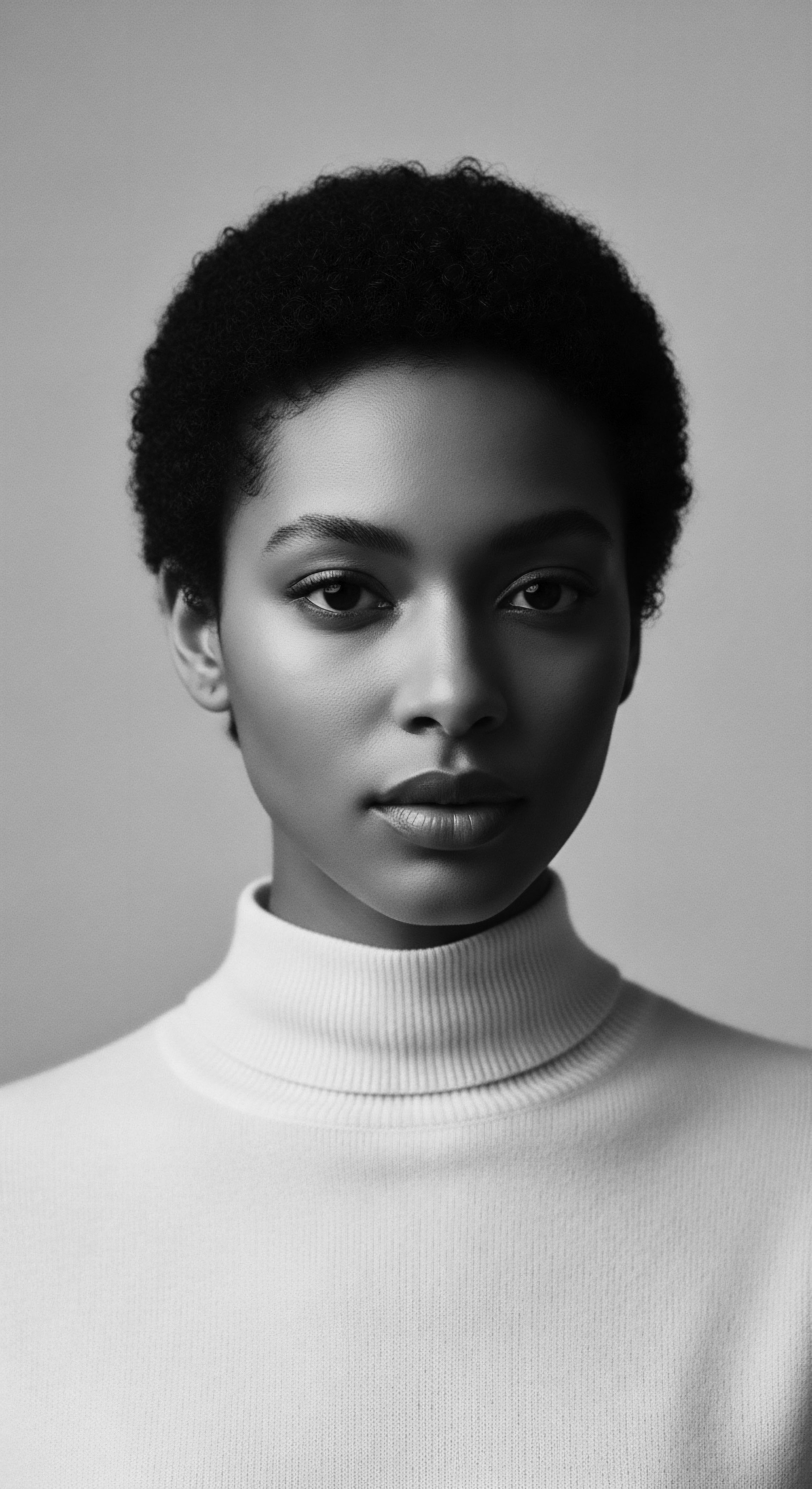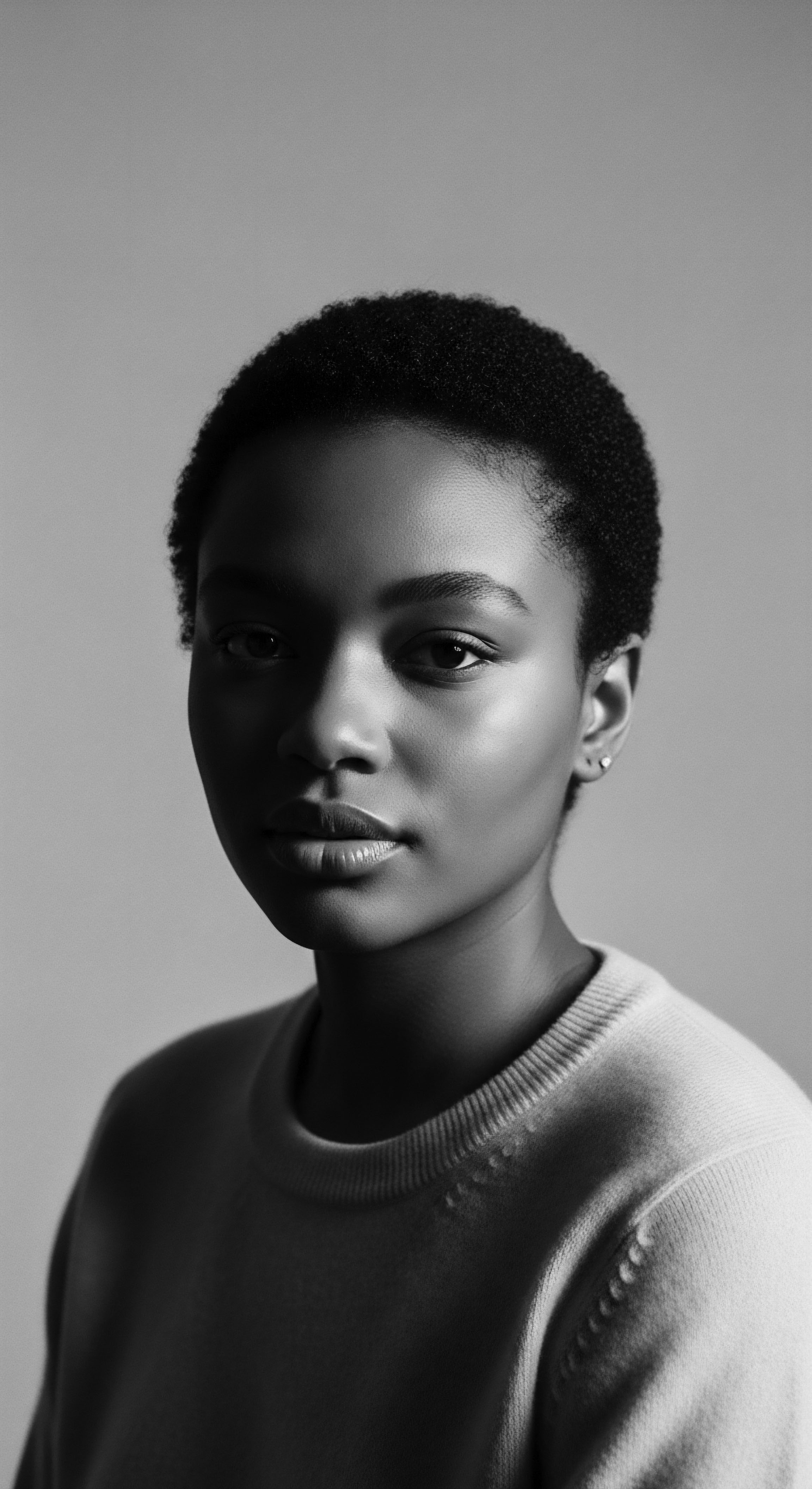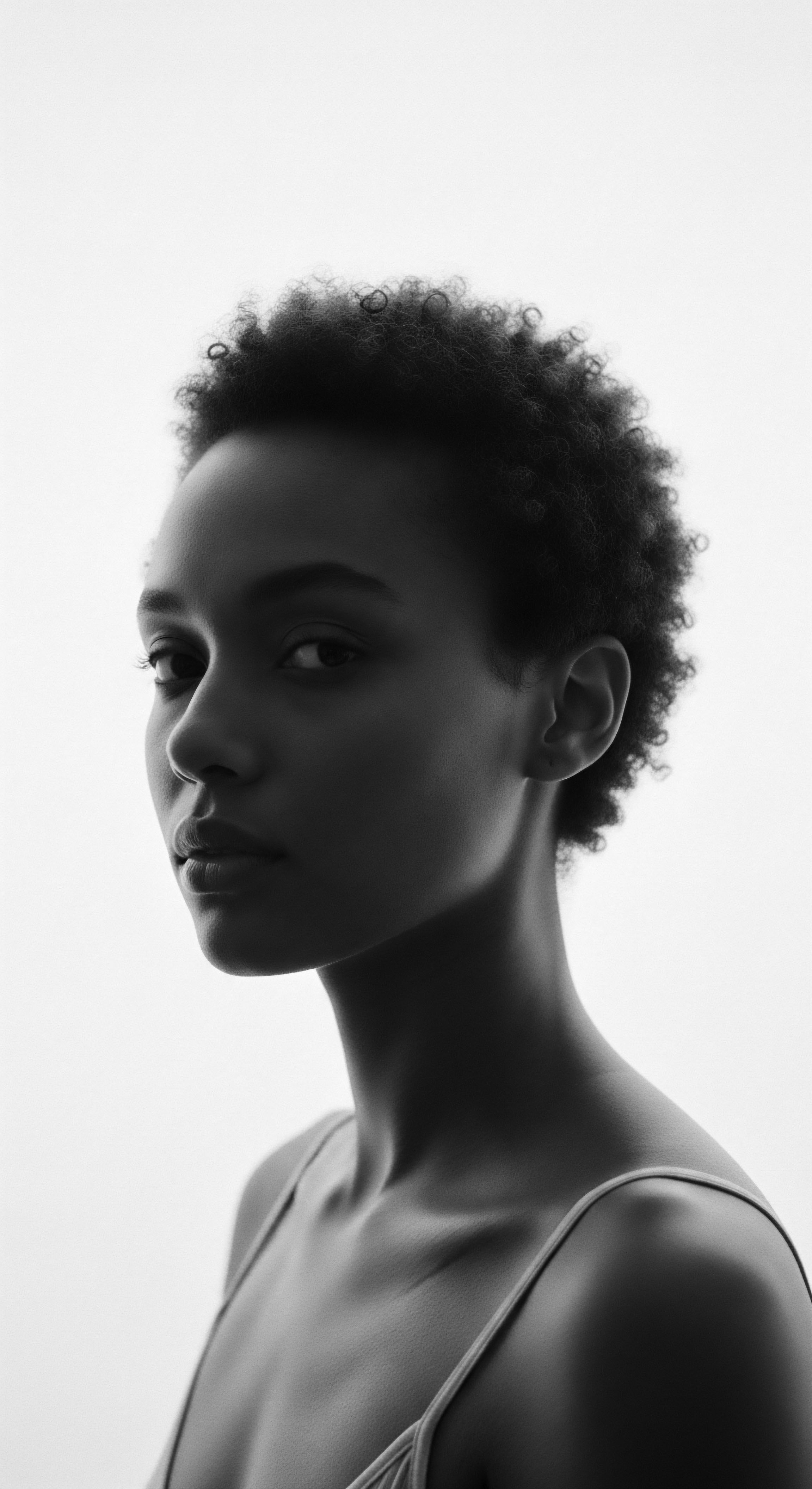
Roots
Consider, if you will, the living crown many of us wear, a wondrous landscape of coils and textures, each strand a testament to resilience and an ancient wisdom. It is a crown that speaks not only of present beauty but of journeys long past, of hands that first cared for it under ancestral skies. To truly grasp why this hair, this textured hair, continually seeks sustenance from external lipids, we must look beyond surface observation and journey to the very genesis of its being—to the biological architecture etched by millennia of adaptation, and the enduring practices that recognized its inherent needs. We speak here of a heritage woven into the very structure of the hair itself, a silent dialogue between biology and the whispers of tradition.
The very shape of the hair follicle, a crescent moon or an ellipse rather than a perfect circle, dictates the hair’s coiled descent from the scalp. This anatomical distinction is not a mere detail; it is the fundamental reason for the hair’s distinct journey along its shaft. As the strand emerges, its helical form necessitates a more intricate path for the scalp’s natural oils, sebum, to travel. Unlike straighter patterns where sebum can glide down a smoother, more direct route, the twists and turns of a textured strand create obstacles.
This results in an uneven distribution of natural lipids, often leaving the mid-shaft and ends relatively dry, thirsting for an external offering. This anatomical predisposition speaks volumes about hair’s historical needs.
The elliptical shape of the textured hair follicle inherently challenges the even distribution of natural scalp oils along the hair shaft.

Hair Anatomy and Physiological Uniqueness
The cuticle, the hair’s outermost protective layer, serves as its shield against the world. In textured hair, these shingle-like scales are often more lifted, less tightly compressed than in straighter patterns. This raised cuticle, while contributing to the hair’s volume and its ability to hold intricate styles, also presents a vulnerability. It creates microscopic pathways for moisture to escape and for environmental aggressors to intrude.
Conversely, it also offers more surface area for external lipids to adhere, creating a protective barrier that seals moisture within. The need for this external seal is a biological echo from the earliest days of textured hair. Our ancestral kin, through generations of observation, understood this need long before microscopes revealed cellular truths. Their practices, often involving the liberal application of plant-derived butters and oils, were, at their heart, a direct response to this physiological characteristic.

Ancestral Definitions of Hair Characteristics
Traditional classifications of hair, predating modern scientific frameworks, often recognized hair’s distinct properties through lived experience and visual cues. While not formal scientific categories, these informal taxonomies—whether expressed through local dialects or shared cultural understandings—acknowledged differences in hair’s feel, its response to moisture, and its thirst. Communities described hair as “thirsty,” “dry,” “soft,” or “rough,” terms that inherently pointed to its lipid requirements. These observations formed the bedrock of care practices, leading to the generational refinement of techniques and the selection of ingredients rich in the very lipids the hair craved.
- Shea Butter ❉ Across West Africa, its use spans centuries, a balm against the elements, deeply saturating strands.
- Coconut Oil ❉ A staple in many Afro-Diasporic communities, revered for its ability to penetrate and provide sustained moisture.
- Castor Oil ❉ Known in various cultures for its thickness and ability to coat strands, offering substantial barrier protection.

Hair Growth Cycles and Ancient Influences
The hair growth cycle, a continuous rhythm of growth, rest, and shedding, remains largely consistent across all hair types. Yet, the environmental context in which textured hair historically developed played a role in its lipid requirements. Exposure to harsh sun, dry winds, and arid climates for ancestral populations meant an increased need for external protection. The very elements that prompted the evolution of textured hair’s unique structure—its density offering scalp protection from UV radiation, its coils retaining humidity in humid environments—also heightened its vulnerability to dryness when exposed to less forgiving climes or when natural sebum distribution was insufficient.
The ancestral memory of climate, etched into the hair’s very structure, continues to whisper its needs. This continuous cycle meant a continuous need for external protection to maintain hair’s integrity against environmental stressors.

Ritual
The hands that tend to textured hair perform more than a mere application of product; they participate in a ritual, a continuation of practices that span generations. From ancestral villages where communal hair care was a cornerstone of social life to contemporary spaces of self-care, the use of external lipids has remained central. These practices are not isolated acts; they are threads in a grand design, connecting us to a shared past, to knowledge passed down through touch and oral tradition. The very act of applying oils and butters becomes a meditation, a silent communion with the hair’s innate heritage.

Protective Styling Traditions
Protective styles—braids, twists, cornrows, and buns—are a testament to the ingenuity of ancestral communities. These styles served multiple purposes beyond aesthetics ❉ they minimized manipulation, shielded the hair from environmental damage, and importantly, facilitated the retention of moisture. The application of external lipids, typically rich butters and oils, was indispensable to these styles. Before braiding or twisting, strands were generously coated, providing a lubricating barrier that eased the styling process and, critically, locked in hydration for the duration of the style.
This practice reduced friction, prevented breakage, and ensured the hair remained pliable and healthy, even when tucked away for weeks. The tradition of oiling the scalp and strands before braiding speaks to a deep, inherited wisdom concerning hair preservation.

How Did Ancestral Practices Shape Lipid Application?
Across various communities, the method of applying lipids was often as ritualized as the styles themselves. In some traditions, specific oils were warmed gently over open flames or by body heat before being massaged into the scalp and along the hair shaft. This process was believed to enhance absorption and promote circulation, a holistic approach that recognized the scalp as an extension of the body’s overall wellbeing. The choice of lipid was often localized, drawing upon indigenous flora.
For example, in many parts of West Africa, shea butter was not merely a moisturizer; it was a revered ingredient, its application steeped in cultural significance and communal bonding. These meticulous applications underscore a historical understanding of hair’s fragility and its need for robust external nourishment.
| Aspect Lipid Source |
| Ancestral Practice Regionally available plant butters, animal fats |
| Contemporary Parallel Globally sourced plant oils, synthesized ceramides, fatty alcohols |
| Aspect Application Method |
| Ancestral Practice Warmed, hand-massaged, often communal ritual |
| Contemporary Parallel Pre-poo, leave-in, styling creams, deep conditioners, solo or salon care |
| Aspect Primary Goal |
| Ancestral Practice Protection from elements, length retention, communal beauty ritual |
| Contemporary Parallel Moisture retention, frizz control, damage repair, styling versatility |
| Aspect The enduring need for external lipids in textured hair care bridges ancient wisdom with modern scientific understanding. |

Natural Styling and Definition
The aspiration for definition, for coils that spring with clarity and vibrancy, has long been a pursuit within textured hair communities. This desire is often met through the precise application of lipids, which serve as agents of transformation. Oils and butters weigh down individual strands just enough to encourage pattern formation, reducing frizz and allowing the natural curl to cluster.
The ancestral methods for achieving this often involved mixing specific oils with water or herbal infusions to create hydrating elixirs that softened hair and enhanced its innate structure. The act of “setting” the hair with a rich lipid, whether through a traditional twist-out or a modern wash-and-go, serves to seal the cuticle, minimizing the evaporation of water and providing a supple, lustrous finish.

The Complete Textured Hair Toolkit
The tools of hair care have evolved, yet their underlying purpose, often intertwined with lipid application, remains constant. From broad-toothed wooden combs used in ancient times to detangle strands softened by oils, to modern wide-tooth combs and fingers, the gentle separation of hair, lubricated by lipids, has been a consistent practice. The act of raking a generous amount of oil or butter through sections of hair before combing reduces mechanical stress, preventing breakage and preserving the integrity of the hair shaft. This toolkit, whether ancient or modern, serves the overarching goal of supporting the hair’s natural inclination towards dryness and offering it the external fortification it requires.

Relay
The conversation surrounding textured hair’s constant call for external lipids does not reside solely in ancient lore or biological fact; it lives on, a continuous relay of knowledge from one generation to the next, adapting to new understandings yet always rooted in fundamental principles. This section explores how this inherent requirement shapes holistic care, problem-solving, and even the sacred nighttime rituals that preserve the hair’s vitality. We approach this subject not as an isolated scientific query but as a living inheritance, where science often echoes the ancestral wisdom that preceded it.

Building Personalized Textured Hair Regimens
The very notion of a personalized hair regimen, one that addresses the unique needs of an individual’s textured strands, finds its roots in the observant practices of our forebears. They recognized that hair, like skin, responded differently to the elements and to various emollients. This led to a nuanced selection of plant oils and butters, often mixed and matched based on local availability and observed efficacy. Modern science, with its analytical precision, now confirms what tradition instinctively understood ❉ that the specific fatty acid profiles of certain lipids offer distinct benefits.
For instance, the richness of a mango butter might suit a very dry, dense coil, while a lighter argan oil could be preferred for a finer, looser pattern. The creation of such regimens is a contemporary expression of an inherited adaptive spirit.

Why Do Nighttime Rituals Prioritize Lipid Protection?
The passage from day to night for textured hair has long carried a special significance, often accompanied by protective rituals that speak directly to the need for lipid fortification. The practice of wrapping hair in soft fabrics—silk or satin bonnets and scarves—is not merely about preserving a style; it is a profound act of care, a legacy passed down through generations. These coverings prevent friction against absorbent cotton pillowcases, which can strip precious moisture and external lipids from the hair shaft. More importantly, they create a micro-climate around the hair, allowing any applied oils or butters to slowly absorb and seal, rather than evaporate into the air.
This ritual underscores a deep comprehension of how to protect hair’s moisture balance, a critical aspect of mitigating its inherent dryness. The continuity of this practice, from the elaborate headwraps of queens to the nightly bonnets worn by countless individuals, is a living testament to its efficacy and cultural significance.
Nighttime rituals involving soft wraps and bonnets are a critical ancestral practice for preserving textured hair’s moisture and external lipids.

Ingredient Deep Dives for Textured Hair Needs
When we consider the vast array of ingredients utilized in textured hair care, especially those rich in lipids, we are not simply looking at chemical compounds. We are looking at a botanical archive, a repository of natural intelligence passed down through ancestral lines. Consider the widespread reverence for Shea Butter (Vitellaria paradoxa), its rich, emollient qualities celebrated across West and East Africa for centuries. Anthropologist Niara Sudarkasa documented the pervasive use of shea butter in West African communities, noting its vital role in protecting skin and hair from harsh environmental conditions (Sudarkasa, 1996).
Its high concentration of oleic and stearic acids creates a formidable barrier, shielding strands from moisture loss. Similarly, the use of Palm Kernel Oil (Elaeis guineensis) in West African hair traditions, or Babassu Oil (Attalea speciosa) in parts of South America, speaks to a localized wisdom about lipids’ ability to condition and fortify hair. These are not merely ingredients; they are cultural touchstones, each with its own history of utility and communal esteem.
The modern scientific lens offers further clarity on why these ancestral choices were so effective. Textured hair’s unique structure, with its often raised cuticles and numerous twists, struggles to retain water. Lipids, being hydrophobic, act as a sealant. They fill the microscopic gaps in the cuticle, creating a smoother surface that minimizes water evaporation.
This action directly counteracts the hair’s natural inclination to release moisture into the atmosphere. The saturated and monounsaturated fatty acids prevalent in many traditional oils are particularly effective at this, offering both surface conditioning and, in some cases, a limited ability to penetrate the hair shaft itself, providing internal suppleness.
- Avocado Oil ❉ A favored lipid, offering a richness of monounsaturated fatty acids that coat and condition the hair.
- Jojoba Oil ❉ Structurally similar to natural sebum, making it a highly compatible and effective conditioning agent.
- Murumuru Butter ❉ A dense Amazonian lipid, known for its ability to soften and seal highly porous strands.

Problem Solving Compendium
The common challenges associated with textured hair—dryness, breakage, and frizz—are often direct consequences of its anatomical makeup and environmental interaction. The ancestral solutions to these concerns, often involving generous applications of lipids, were empirically derived responses. Dryness, the perpetual adversary, was combatted through continuous re-oiling and the use of occlusive butters. Breakage, frequently linked to dry, brittle strands and excessive friction, was minimized by lubricating the hair with oils before manipulation and by utilizing protective styles that reduced exposure and mechanical stress.
Frizz, which arises when the cuticle lifts in search of moisture, was tamed by smoothing the hair with lipids, effectively sealing the cuticle and reducing its reactivity to humidity. This historical problem-solving, rooted in the consistent application of external lipids, provides a powerful historical context for contemporary hair care strategies.
The application of external lipids is a time-honored approach to combat textured hair’s dryness, breakage, and frizz, problems stemming from its inherent structure.
The wisdom passed down through generations, often through the communal act of hair dressing, taught that regular oiling was not a luxury but a necessity. It was a proactive measure, a preventative shield against the elements and the wear and tear of daily life. This continuous reapplication of external lipids is a testament to the hair’s enduring need and the wisdom of those who sought to meet it, ensuring the hair’s vibrancy and strength.

Reflection
To consider why textured hair so ardently seeks external lipids is to embark on a journey that winds through the very helix of its biology, into the vibrant chronicle of ancestral customs, and out into the expansive landscape of self-expression. Each coil, each curve, carries within it the echoes of a deep past, a heritage that has learned to thrive by embracing external sustenance. The wisdom of our ancestors, who intuitively understood the hair’s thirst and offered it the richest gifts of the earth, is now affirmed by the precise lens of science.
This living dialogue between biological necessity and inherited wisdom is the very soul of a strand. It speaks of continuity, of resilience, and of an ongoing conversation between our crowns and the elements that have shaped them.
The act of oiling, of buttering, of tending to textured hair with a tender hand, transcends mere cosmetic application. It becomes a ritual of remembrance, a celebration of heritage, and a declaration of self-acceptance. It is a profound acknowledgment that the hair’s historical journey, marked by unique physiological needs, has bequeathed to us a blueprint for care. This understanding guides not only our daily routines but also our appreciation for the enduring legacy of textured hair, a legacy that continues to flourish, nurtured by the external lipids it has always known to seek.

References
- Byrd, A. (2001). Hair Story ❉ Untangling the Roots of Black Hair in America. St. Martin’s Griffin.
- Johnson, A. (2014). African American Hair Care ❉ A Cultural and Historical Journey. Praeger.
- Mohs, M. (2006). The Science of Hair Care. CRC Press.
- Robbins, C. R. (2012). Chemical and Physical Behavior of Human Hair. Springer.
- Sudarkasa, N. (1996). The Strength of Our Mothers ❉ African & African American Women and Families ❉ Essays and Speeches. Africa World Press.
- Tewari, D. (2018). Ethnobotany of African Medicinal Plants. Academic Press.
- Tiwari, V. (2019). Hair Care ❉ Chemistry, Biology and Industry. Wiley.
